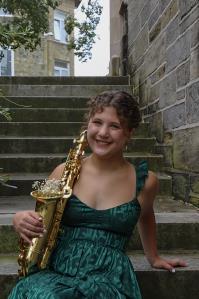ABOUT THE ARTISTS
Emily Abdill, saxophone

Emily is a senior music education major on saxophone at West Chester University. Emily’s passion for music began when she first started playing the saxophone in fourth grade. Throughout grade school, she immersed herself in private lessons, band, choir, musical theatre, and marching band. At the Wells School of Music, she studied saxophone under Professor Ragonese and Dr. Granger, both greatly influencing her growth as a soloist and music educator As a performer she has been a member of the concert band, saxophone ensemble, and the Incomparable Golden Rams Marching Band. Outside of performing, she is a proud sister of Sigma Alpha Iota, a national music fraternity and a member of the National Association for Music Educators. After graduation, she plans to teach elementary music and marching band while continuing her journey both as a saxophonist and as an educator.
Sonata, Paul Creston (1906-1985)
This work was commissioned by American saxophonist Cecil Lawson and composed by Paul Creston It has since become an important contribution to the saxophone’s standard repertoire, establishing the saxophone as a classical instrument The piece consists of three movements, marked by descriptive tempo markings, indicating the character of the movement. The first movement, “With vigor”, is full of energy characterized by contrast between a spirited first theme and lyrical second theme. The second movement, “With tranquility”, directly contrasts with the first, opening with a songlike theme in the piano, then intertwining the saxophone, creating a floating dreamlike atmosphere.
Chanson et Passepied, Jeanine Rueff (1922-1999)
Jeanine Rueff was a French composer who studied at the Conservatoire de Paris, known for collaborative piano as she worked extensively with Marcel Mule. This piece includes two sections, a poetic section and a lively dance section. The “Chanson” features a gently unfolding melody, that is beautifully sculpted by the piano. The “Passepied” is a light and energetic dance, playfully interrupted by a graceful waltz section.
Scaramouche, Darius Milhaud (1892-1974)
This suite draws on music originally composed as incidental music for theatrical productions. The second movement is based on themes from Jules Supervielle’s Opéra Bolivar, while the third is inspired by Henri Pascar’s Le Médecin volant The second movement, “Modere” is a gentle piece, featuring dialogue between the saxophone and piano. In complete contrast, the “Brazileira” is a fast and animated samba. This finale is inspired by Milhaud's time in Brazil, where he was deeply influenced by the Brazilian composer Ernesto Nazareth Milhaud infused this movement with syncopated rhythms and bright melodies depicting a carnival setting
